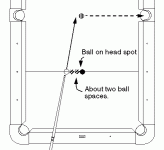Jal said:It is hard to be consistent using outside english on a thin cut. For some shots, throw can vary by around nine degrees over a range of tip offsets which span less than one-tenth of an inch. That's the difference between a large amount of throw in one direction and a similar amount in the other direction, and assuming a reasonably fast cueball speed to move the object ball (the span is even greater at slower speeds). As you approach 90 degrees, the offsets that produce one or the other come closer and closer together.
On the other hand, throw is almost constant for thin cuts when using either pure stun, any amount of follow or draw, and even random amounts inside english. In all of these cases, it's predicted to be 0.5 to 0.9 degree, and mostly in the 0.6 to 0.8 degree range for fairly brisk cueball speeds (7 mph and up).
I think the moral is that if you absolutely have to throw the object ball in the reverse direction, outside is the way to go. But it's pretty much of a crap shoot as to what results you'll see. You can overspin it to get a more moderate and predictable amount of throw. But for cuts sixty degrees or more, you have to get precariously close to the miscue limit to do so (you're already close just to get it to reverse in the first place).
Just more babble.
Jim
Thats some interesting babble though, IMO.
Last edited:
